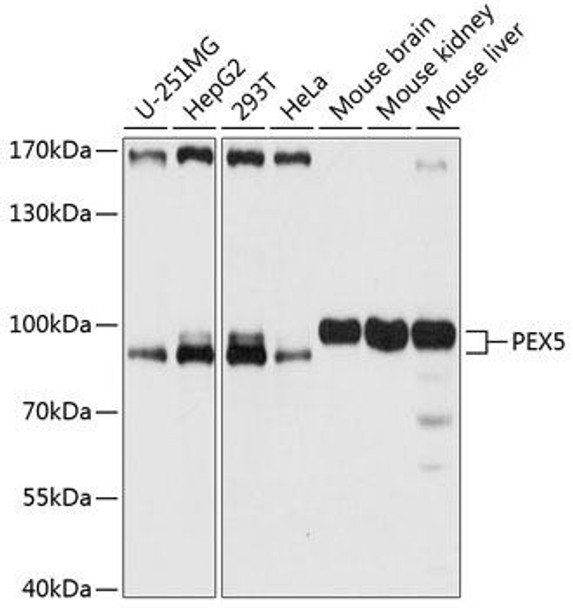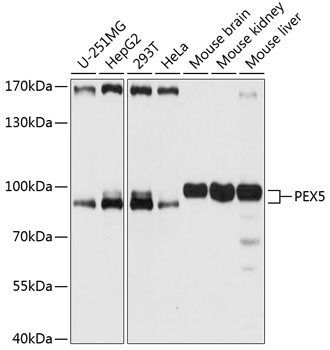Anti-PEX5 Antibody (CAB12493)
- SKU:
- CAB12493
- Product type:
- Antibody
- Reactivity:
- Human
- Mouse
- Host Species:
- Rabbit
- Isotype:
- IgG
- Antibody Type:
- Polyclonal Antibody
- Research Area:
- Cell Biology
Frequently bought together:
Description
| Antibody Name: | Anti-PEX5 Antibody |
| Antibody SKU: | CAB12493 |
| Antibody Size: | 20uL, 50uL, 100uL |
| Application: | WB |
| Reactivity: | Human, Mouse |
| Host Species: | Rabbit |
| Immunogen: | Recombinant fusion protein containing a sequence corresponding to amino acids 364-631 of human PEX5 (NP_000310.2). |
| Application: | WB |
| Recommended Dilution: | WB 1:500 - 1:2000 |
| Reactivity: | Human, Mouse |
| Positive Samples: | U-251MG, HepG2, 293T, HeLa, Mouse brain, Mouse kidney, Mouse liver |
| Immunogen: | Recombinant fusion protein containing a sequence corresponding to amino acids 364-631 of human PEX5 (NP_000310.2). |
| Purification Method: | Affinity purification |
| Storage Buffer: | Store at -20°C. Avoid freeze / thaw cycles. Buffer: PBS with 0.02% sodium azide, 50% glycerol, pH7.3. |
| Isotype: | IgG |
| Sequence: | WQYL GTTQ AENE QELL AISA LRRC LELK PDNQ TALM ALAV SFTN ESLQ RQAC ETLR DWLR YTPA YAHL VTPA EEGA GGAG LGPS KRIL GSLL SDSL FLEV KELF LAAV RLDP TSID PDVQ CGLG VLFN LSGE YDKA VDCF TAAL SVRP NDYL LWNK LGAT LANG NQSE EAVA AYRR ALEL QPGY IRSR YNLG ISCI NLGA HREA VEHF LEAL NMQR KSRG PRGE GGAM SENI WSTL RLAL SMLG QSDA YGAA DARD LSTL LTMF GLPQ |
| Gene ID: | 5830 |
| Uniprot: | P50542 |
| Cellular Location: | Cytoplasm, Peripheral membrane protein, Peroxisome membrane |
| Calculated MW: | 66kDa/69kDa/70kDa/72kDa |
| Observed MW: | 71kDa |
| Synonyms: | PEX5, PBD2A, PBD2B, PTS1-BP, PTS1R, PXR1, RCDP5 |
| Background: | The product of this gene binds to the C-terminal PTS1-type tripeptide peroxisomal targeting signal (SKL-type) and plays an essential role in peroxisomal protein import. Peroxins (PEXs) are proteins that are essential for the assembly of functional peroxisomes. The peroxisome biogenesis disorders (PBDs) are a group of genetically heterogeneous autosomal recessive, lethal diseases characterized by multiple defects in peroxisome function. The peroxisomal biogenesis disorders are a heterogeneous group with at least 14 complementation groups and with more than 1 phenotype being observed in cases falling into particular complementation groups. Although the clinical features of PBD patients vary, cells from all PBD patients exhibit a defect in the import of one or more classes of peroxisomal matrix proteins into the organelle. Defects in this gene are a cause of neonatal adrenoleukodystrophy (NALD), a cause of Zellweger syndrome (ZWS) as well as may be a cause of infantile Refsum disease (IRD). Alternatively spliced transcript variants encoding different isoforms have been identified. |
| UniProt Protein Function: | PEX5: Binds to the C-terminal PTS1-type tripeptide peroxisomal targeting signal (SKL-type) and plays an essential role in peroxisomal protein import. Defects in PEX5 are a cause of adrenoleukodystrophy neonatal (NALD). NALD is a peroxisome biogenesis disorder (PBD) characterized by the accumulation of very long- chain fatty acids, adrenal insufficiency and mental retardation. Inheritance is autosomal recessive. Defects in PEX5 are a cause of Zellweger syndrome (ZWS). ZWS is a fatal peroxisome biogenesis disorder characterized by dysmorphic facial features, hepatomegaly, ocular abnormalities, renal cysts, hearing impairment, profound psychomotor retardation, severe hypotonia and neonatal seizures. Death occurs within the first year of life. Defects in PEX5 may be a cause of infantile Refsum disease (IRD). IRD is a mild peroxisome biogenesis disorder (PBD). Clinical features include early onset, mental retardation, minor facial dysmorphism, retinopathy, sensorineural hearing deficit, hepatomegaly, osteoporosis, failure to thrive, and hypocholesterolemia. The biochemical abnormalities include accumulation of phytanic acid, very long chain fatty acids (VLCFA), di- and trihydroxycholestanoic acid and pipecolic acid. Belongs to the peroxisomal targeting signal receptor family. 4 isoforms of the human protein are produced by alternative splicing. |
| UniProt Protein Details: | Protein type:Membrane protein, integral; Receptor, protein translocating Chromosomal Location of Human Ortholog: 12p13.31 Cellular Component: cytoplasm; cytosol; Golgi apparatus; membrane; peroxisomal membrane; peroxisome; protein complex Molecular Function:enzyme binding; peroxisome matrix targeting signal-1 binding; peroxisome targeting sequence binding; protein binding; protein N-terminus binding; small GTPase binding Biological Process: protein import into peroxisome matrix; protein import into peroxisome matrix, docking; protein import into peroxisome membrane Disease: Peroxisome Biogenesis Disorder 2a (zellweger); Peroxisome Biogenesis Disorder 2b; Rhizomelic Chondrodysplasia Punctata, Type 5 |
| NCBI Summary: | The product of this gene binds to the C-terminal PTS1-type tripeptide peroxisomal targeting signal (SKL-type) and plays an essential role in peroxisomal protein import. Peroxins (PEXs) are proteins that are essential for the assembly of functional peroxisomes. The peroxisome biogenesis disorders (PBDs) are a group of genetically heterogeneous autosomal recessive, lethal diseases characterized by multiple defects in peroxisome function. The peroxisomal biogenesis disorders are a heterogeneous group with at least 14 complementation groups and with more than 1 phenotype being observed in cases falling into particular complementation groups. Although the clinical features of PBD patients vary, cells from all PBD patients exhibit a defect in the import of one or more classes of peroxisomal matrix proteins into the organelle. Defects in this gene are a cause of neonatal adrenoleukodystrophy (NALD), a cause of Zellweger syndrome (ZWS) as well as may be a cause of infantile Refsum disease (IRD). Alternatively spliced transcript variants encoding different isoforms have been identified. [provided by RefSeq, Oct 2008] |
| UniProt Code: | P50542 |
| NCBI GenInfo Identifier: | 119364633 |
| NCBI Gene ID: | 5830 |
| NCBI Accession: | P50542.3 |
| UniProt Secondary Accession: | P50542,Q15115, Q15266, Q96FN7, A8K891, B4DZ45, B7ZAD5 D3DUT8, |
| UniProt Related Accession: | P50542 |
| Molecular Weight: | 71kDa |
| NCBI Full Name: | Peroxisomal targeting signal 1 receptor |
| NCBI Synonym Full Names: | peroxisomal biogenesis factor 5 |
| NCBI Official Symbol: | PEX5 |
| NCBI Official Synonym Symbols: | PXR1; PBD2A; PBD2B; PTS1R; RCDP5; PTS1-BP |
| NCBI Protein Information: | peroxisomal biogenesis factor 5 |
| UniProt Protein Name: | Peroxisomal targeting signal 1 receptor |
| UniProt Synonym Protein Names: | PTS1-BP; Peroxin-5; Peroxisomal C-terminal targeting signal import receptor; Peroxisome receptor 1 |
| Protein Family: | PEX5-related protein |
| UniProt Gene Name: | PEX5 |








